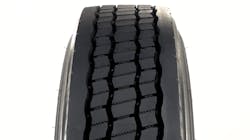Maintain last-mile tires to lengthen their lifespans
Last-mile deliveries (LMD) operations are booming with the incredible growth of e-commerce sales over the past year and if the trends form the U.S. Department of Commerce are any indication, this state of affairs is not likely to change any time soon. But with the increase of home delivery also comes an increase in stress on commercial vehicles, and particularly on the tires that scuff and drop from curbs all across the country.
However, both drivers and maintenance providers can lighten the load on last-mile tires and lengthen their lifespans with careful, consistent inspection and maintenance.
Read more: Tips to ensure uptime on urban routes
Maintain to retread
Although LMD urban pickup-and-delivery trucks operate mainly in local areas and run short miles compared to long-haul applications, last-mile tires don’t last all that long compared to their over-the-road counterparts. From what Keith Iwinski, director of fleet marketing for commercial, Bandag, Bridgestone Americas Tire Operations, has seen, tires for LMD applications last only about three months. That’s why many fleets are doing what they can to salvage their initial tire casings and capitalize on retreading.
“For a vehicle that has a 17.5” tire or is a decent size steel tire, you are going to look into retreading because the retread tire will last as long as the new tire, and you’re able to use your asset another time,” Iwinski said.
Part of that preventive maintenance means ensuring LMD tires are correctly inflated and regularly rotated. That includes monitoring tire pressure and following manufacturers’ pull-point recommendations.
Typically, the federal commercial tire pull point is 2/32nds. Bridgestone tells its LMD fleet customers that pull points for their operations should be in the 3/32nds and 4/32nds range, so they have the capacity to retread, Iwinski explained.
The key is not allowing the tire casing to become too far worn or for the belt package to become injured beyond repair, otherwise the casing likely won’t be salvageable for retreading, Iwinski advised. Equally important is education on driving conditions—where the vehicle is being operated, how it is being operated, start-and-stop frequency, and debris.
“A lot of times you get punctures on rainy days because water acts as a lubricant, so things that cut tires cut them easier on rainy days,” Iwinski explained. “Curbing affects casing integrity. So, if you’re pulling up to a house, stay a little bit away from the curb so you can save your tire. When you are backing up, make sure you are not backing up over curbs because of pin shock.
“It’s okay to walk another 100 feet to deliver the package if you see you are in a construction area,” he added. “That will save your casings in the long run.”
Overall, if the LMD vehicle has a balance or alignment issue, tires are going to wear out much faster.
“When people don’t do pre-trips or post-trips, what ends up happening is that tire injury is an injury on the road,” Iwinski emphasized. “As an LMD fleet, when that happens, packages have to be loaded onto another vehicle. Now, the fleet is one truck down because the driver didn’t do a pre-trip or a post-trip.”
Read more: Saving with tire section repairs
Monitoring tread life
Technology also has a role to play when it comes to keeping track of tire health. Bridgestone’s IntelliTire solution, for example, automatically measures and monitors tire pressure and tread depth when vehicles drive over a sensor mat. When vehicles pull into the yard, the onboard system will inform fleets and service dealers when a unit has a flat so the tire can be changed before its next scheduled delivery.
Similarly, Continental’s ContiConnect Yard Reader is a digital tire monitoring solution that can be mounted at a distribution center or fleet terminal to identify any tires with low air pressure or high temperature before they leave. Optimal for vehicles that return to the fleet yard at least once a week, ContiConnect’s web portal displays tire data such as pressure, casing temperature, and valve damage and air leaks to fleet personnel if a problem is detected.
On commercial tires, such as the Cooper Tire PRO Series Long Haul Steer 2, the company implements a Wear Square, a visual indicator on the shoulder ribs that starts as an “A,” and becomes an “L” at half tread life, and an exclamation mark when it needs to be replaced. The difference between the markings on either side of the tire also indicate alignment issues. Misalignments can exacerbate wear.
Goodyear Tire & Rubber Co. also has a handheld digital tire tool called Tire Optix, with one end to measure tread depth while the other attaches to the valve stem to check pressure. The data is sent via Bluetooth to a mobile app, which tracks what trucks have problem tires.
“We inspect about 2 million tires a year with Tire Optix, and it’s all about creating efficiencies and accuracies during this tire inspection process,” said Jamie Redmond, Goodyear customer engagement specialist.
Goodyear’s CheckPoint drive-over-reader uses micro-transducers, lasers, and cameras to detect tread depth and pressure, and it can be used for vehicles ranging from passenger vehicles to Class 8 tractor-trailers, with options for in-ground installation or 2-3” ramp style above ground option.
Hunter Engineering Company’s Quick Tread Heavy-Duty automated tire inspection system provides fleets the ability to “get a quick glimpse of the state of that vehicle within a matter of seconds as it passes through, and there is no human involvement at all,” said Tommy Maitz, director of marketing at Hunter. The camera system takes images every time a vehicle passes through; in the ground, lasers read tire tread depth, and multiple angles capture the inboard side as well to provide wide inspection coverage. Quick Tread Heavy-Duty can read single tires at the front of the vehicle as well as duals or super singles.
About the Author

Cristina Commendatore
Cristina Commendatore is the Executive Editor of FleetOwner magazine. She has reported on the transportation industry since 2015, covering topics such as business operational challenges, driver and technician shortages, truck safety, and new vehicle technologies. She holds a master’s degree in journalism from Quinnipiac University in Hamden, Connecticut.


